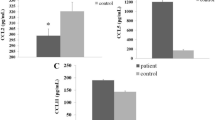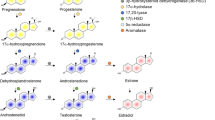Abstract
Epidemiological and clinical studies have shown a great difference in the severity and prevalence of infectious diseases in men and women and various studies have shown that the key immunological factors are affected by sex-associated hormones. Considering the role of sex hormones in various infections, the current study aimed to determine the level of sex hormones in patients with cutaneous leishmaniasis (CL) and malaria and compare it with those of healthy controls. The survey was designed as a case–control study. Peripheral blood was collected from thirty male malaria patients, sixty patients (equal number of both sexes) with cutaneous leishmaniasis and ninety healthy subjects. Disease confirmations were done through microscopic examination of either peripheral blood smears, in case of malaria, or Giemsa-stained lesion imprint slides for CL. The level of testosterone, progesterone and estrogen were measured in malaria and CL patients along with healthy subjects, using an ELISA commercial kit. Age of participants was 18–35 years (mean 25.39 ± 4.70) for CL patients and 14–41 years (mean 27.63 ± 9.09) for malaria patients. Differences between the age of patients and the healthy subjects were insignificant. The level of testosterone in malaria patients (1.44 ± 0.12 ng/mL) was lower than control group (1.46 ± 0.06, ng/mL) but the differences were not statistically significant (p > .05). The concentration of testosterone in CL patients (1.49 ± 0.03 ng/mL) was higher than those of control group (1.46 ± 0.06 ng/mL), and the difference was statistically significant (p = 0.05). Although the concentration of estrogen and progesterone in CL patients were lower than controls, still the differences were not statistically significant (p > 0.05). Findings of the current study demonstrated a significant difference in the serum level of testosterone in CL patients in comparison with the healthy subjects whereas such difference was not seen in malaria patients.
Similar content being viewed by others
References
Abdagalil MA, ElBagir NM (2009) Effect of falciparum malaria on some plasma proteins in males: with special reference to the levels of testosterone and cortisol. Afr J Biochem Res 3(11):349–355
Alvar J, Vélez ID, Bern C, Herrero M, Desjeux P, Cano J, Jannin J, den Boer M, Team WLC (2012) Leishmaniasis worldwide and global estimates of its incidence. PLoS ONE 7(5):e35671
Baccan GC, Oliveira F, Sousa AD, Cerqueira NA, Costa JML, Barral-Netto M, Barral A (2011) Hormone levels are associated with clinical markers and cytokine levels in human localized cutaneous leishmaniasis. Brain Behav Immun 25(3):548–554
Benten W, Wunderlich F, Mossmann H (1992) Testosterone-induced suppression of self-healing Plasmodium chabaudi malaria: an effect not mediated by androgen receptors? J Endocrinol 135(3):407–413
Benten W, Ulrich P, Kühn-Velten W, Vohr H, Wunderlich F (1997) Testosterone-induced susceptibility to Plasmodium chabaudi malaria: persistence after withdrawal of testosterone. J Endocrinol 153(2):275–281
Bernin H, Lotter H (2014) Sex bias in the outcome of human tropical infectious diseases: influence of steroid hormones. J Infect Dis 209(suppl_3):S107–S113
Bouman A, Heineman MJ, Faas MM (2005) Sex hormones and the immune response in humans. Hum Reprod Update 11(4):411–423
Cernetich A, Garver LS, Jedlicka AE, Klein PW, Kumar N, Scott AL, Klein SL (2006) Involvement of gonadal steroids and gamma interferon in sex differences in response to blood-stage malaria infection. Infect Immun 74(6):3190–3203
Cutolo M, Villaggio B, Seriolo B, Montagna P, Capellino S, Straub RH, Sulli A (2004) Synovial fluid estrogens in rheumatoid arthritis. Autoimmun Rev 3(3):193–198
Daily JP (2017) Malaria 2017: update on the clinical literature and management. Curr Infect Dis Rep 19(8):28
Davami MH, Motazedian MH, Sarkari B (2010) The changing profile of cutaneous leishmaniasis in a focus of the disease in Jahrom district, southern Iran. Ann Trop Med Parasitol 104(5):377–382
Escobedo G, Roberts CW, Carrero JC, Morales-Montor J (2005) Parasite regulation by host hormones: an old mechanism of host exploitation? Trends Parasitol 21(12):588–593
Faust Z, Laškarin G, Rukavina D, Szekeres-Bartho J (1999) Progesterone-induced blocking factor inhibits degranulation of natural killer cells. Am J Reprod Immunol 42(2):71–75
Ferede G, Diro E (2017) Visceral leishmaniasis-malaria coinfection and their associated factors in patients attending metema hospital, Northwest Ethiopia: suggestion for integrated vector management. Malar Res Treat 2017:6816913
Folstad I, Karter AJ (1992) Parasites, bright males, and the immunocompetence handicap. Am Nat 139(3):603–622
Ghazeeri G, Abdullah L, Abbas O (2011) Immunological differences in women compared with men: overview and contributing factors. Am J Reprod Immunol 66(3):163–169
Giefing-Kröll C, Berger P, Lepperdinger G, Grubeck-Loebenstein B (2015) How sex and age affect immune responses, susceptibility to infections, and response to vaccination. Aging Cell 14(3):309–321
Hatam GR, Nejati F, Mohammadzadeh T, Shahriari Rad R, Sarkari B (2015) Population-based seroprevalence of malaria in Hormozgan Province, Southeastern Iran: a low transmission area. Malar Res Treat 2015:174570
Khosravani A, Sarkari B, Negahban H, Sharifi A, Toori MA, Eilami O (2012) Hepatitis B Infection among high risk population: a seroepidemiological survey in Southwest of Iran. BMC Infect Dis 12:378
Klein S (2004) Hormonal and immunological mechanisms mediating sex differences in parasite infection. Parasite Immunol 26(6–7):247–264
Klein PW, Easterbrook JD, Lalime EN, Klein SL (2008) Estrogen and progesterone affect responses to malaria infection in female C57BL/6 mice. Gend Med 5(4):423–433
Kurtis JD, Mtalib R, Onyango FK, Duffy PE (2001) Human resistance to Plasmodium falciparum increases during puberty and is predicted by dehydroepiandrosterone sulfate levels. Infect Immun 69(1):123–128
Legorreta-Herrera M, Mosqueda-Romo NA, Nava-Castro KE, Morales-Rodríguez AL, Buendía-González FO, Morales-Montor J (2015) Sex hormones modulate the immune response to Plasmodium berghei ANKA in CBA/Ca mice. Parasitol Res 114(7):2659–2669
Lezama-Davila C, Oghumu S, Satoskar A, Isaac-Marquez A (2007) Sex-associated susceptibility in humans with chiclero’s ulcer: resistance in females is associated with increased serum-levels of GM-CSF. Scand J Immunol 65(2):210–211
Lotter H, Helk E, Bernin H, Jacobs T, Prehn C, Adamski J, Gonzalez-Roldan N, Holst O, Tannich E (2013) Testosterone increases susceptibility to amebic liver abscess in mice and mediates inhibition of IFNgamma secretion in natural killer T cells. PLoS ONE 8(2):e55694
Mohammadzadeh T, Hatam G, Kalantari M, Sarkari B, Motazedian MH, Sadjjadi SM, Safari R (2014) Molecular and microscopic-based characterization of Plasmodium spp. in Fars and Hormozgan Provinces, South of Iran. J Trop Med 2014:935469
Muñoz G, Davies CR (2006) Leishmania panamensis transmission in the domestic environment: the results of a prospective epidemiological survey in Santander, Colombia. Biomedica 26:131–144
Pandey K, Singh D, Bimal S, Murti K, Das P (2014) Association of testosterone and cholesterol level in modulation of immunity and severity of disease in visceral leishmaniasis patients-a preliminary study. Am J Immunol 10(1):46
Pourmohammadi B, Motazedian MH, Handjani F, Hatam GH, Habibi S, Sarkari B (2011) Glucantime efficacy in the treatment of zoonotic cutaneous leishmaniasis. Southeast Asian J Trop Med Public Health 42(3):502–508
Reithinger R, Mohsen M, Aadil K, Sidiqi M, Erasmus P, Coleman PG (2003) Anthroponotic cutaneous leishmaniasis, Kabul, Afghanistan. Emerg Infect Dis 9(6):727
Robinson DP, Klein SL (2012) Pregnancy and pregnancy-associated hormones alter immune responses and disease pathogenesis. Horm Behav 62(3):263–271
Sarkari B, Pedram N, Mohebali M, Moshfe AA, Zargar MA, Akhoundi B, Shirzadi MR (2010) Seroepidemiological study of visceral leishmaniasis in Booyerahmad district, south-west Islamic Republic of Iran. East Mediterr Health J 16(11):1133–1136
Sarkari B, Hatam G, Ghatee M (2012) Epidemiological features of visceral leishmaniasis in fars province, southern iran. Iran J Public Health 41(4):94–99
Sarkari B, Ahmadpour NB, Motazedian MH, Mirjalali H, Akhoundi M, Mohebali M, Hajjaran H (2016a) Inter- and intraspecific variations of leishmania strains isolated from patients with cutaneous and visceral leishmaniases in Fars Province, South of Iran. Iran J Med Sci 41(3):209–216
Sarkari B, Naraki T, Ghatee MA, Abdolahi Khabisi S, Davami MH (2016b) Visceral leishmaniasis in southwestern Iran: a retrospective clinico-hematological analysis of 380 consecutive hospitalized cases (1999–2014). PLoS ONE 11(3):e0150406
Snider H, Lezama-Davila C, Alexander J, Satoskar AR (2009) Sex hormones and modulation of immunity against leishmaniasis. NeuroImmunoModulation 16(2):106–113
Travi BL, Osorio Y, Melby PC, Chandrasekar B, Arteaga L, Saravia NG (2002) Gender is a major determinant of the clinical evolution and immune response in hamsters infected with Leishmania spp. Infect Immun 70(5):2288–2296
Wunderlich F, Marinovski P, Peter W, Benten M, Schmitt-Wrede HP, Mossmann H (1991) Testosterone and other gonadal factor (s) restrict the efficacy of genes controlling resistance to Plasmodium chabaudi malaria. Parasite Immunol 13(4):357–367
Acknowledgements
The results described in this paper were part of MD thesis of Najme Shakouri. The study was financially supported by the office of vice-chancellor for research of Shiraz University of Medical Sciences (Grant No. 94-01-43-9603).
Author information
Authors and Affiliations
Corresponding author
Rights and permissions
About this article
Cite this article
Esfandiari, F., Sarkari, B., Turki, H. et al. Level of circulating steroid hormones in malaria and cutaneous leishmaniasis: a case control study. J Parasit Dis 43, 54–58 (2019). https://doi.org/10.1007/s12639-018-1055-2
Received:
Accepted:
Published:
Issue Date:
DOI: https://doi.org/10.1007/s12639-018-1055-2




